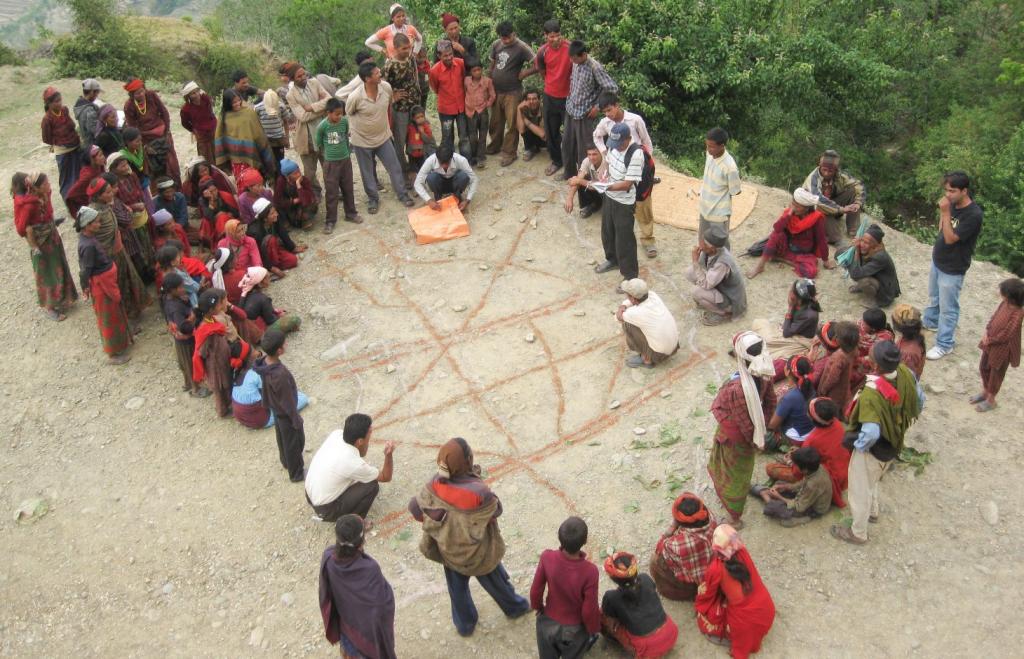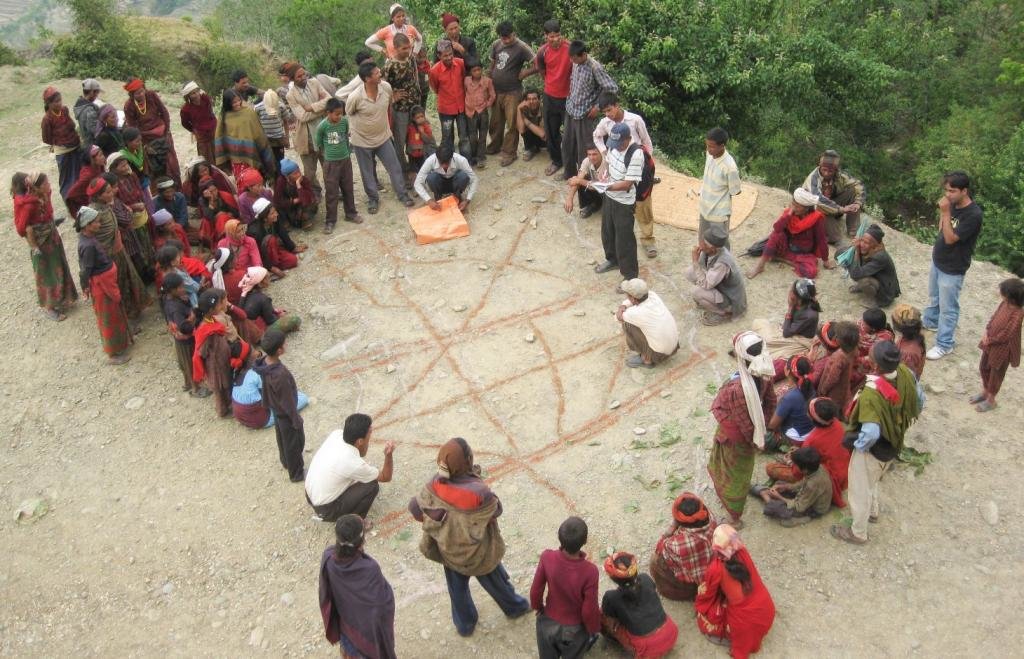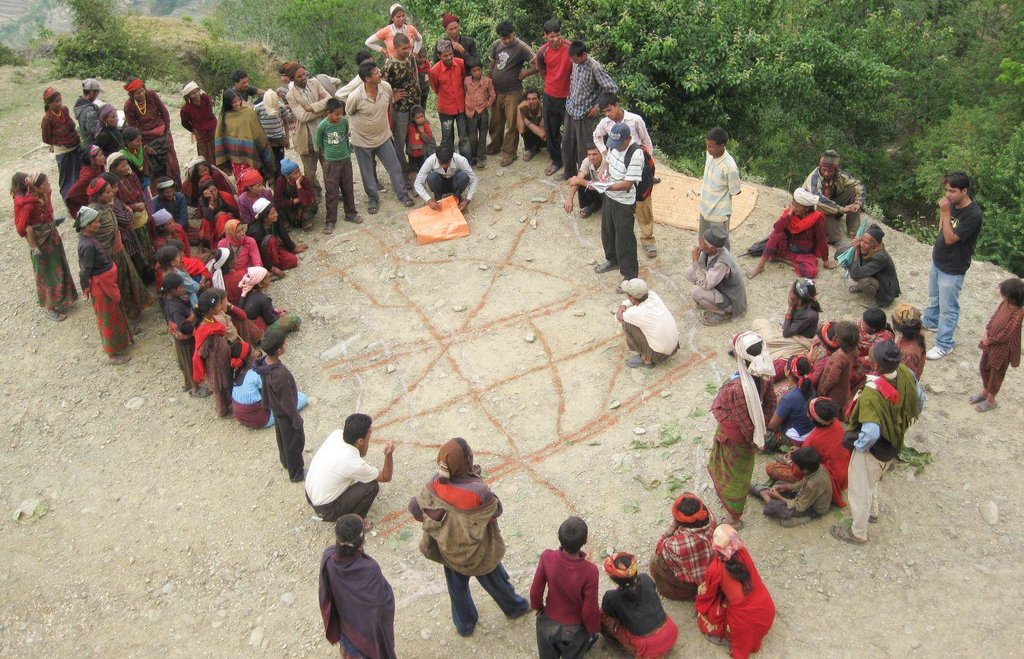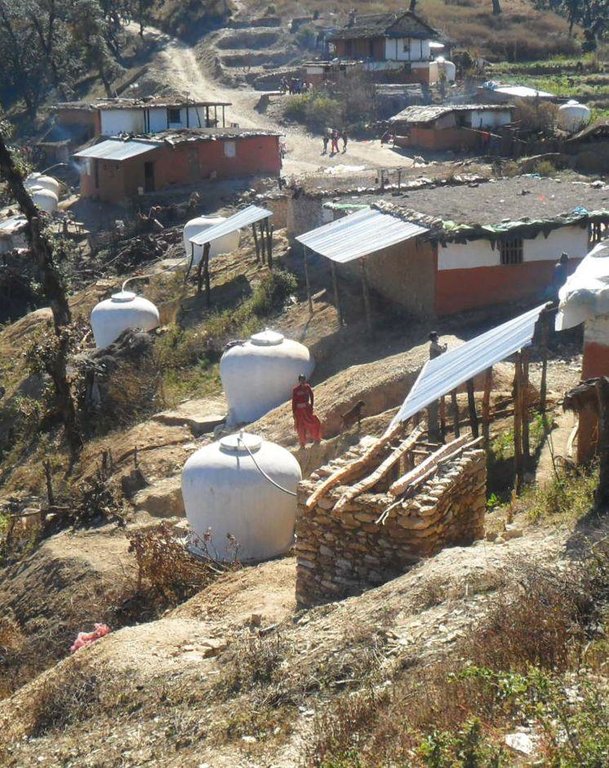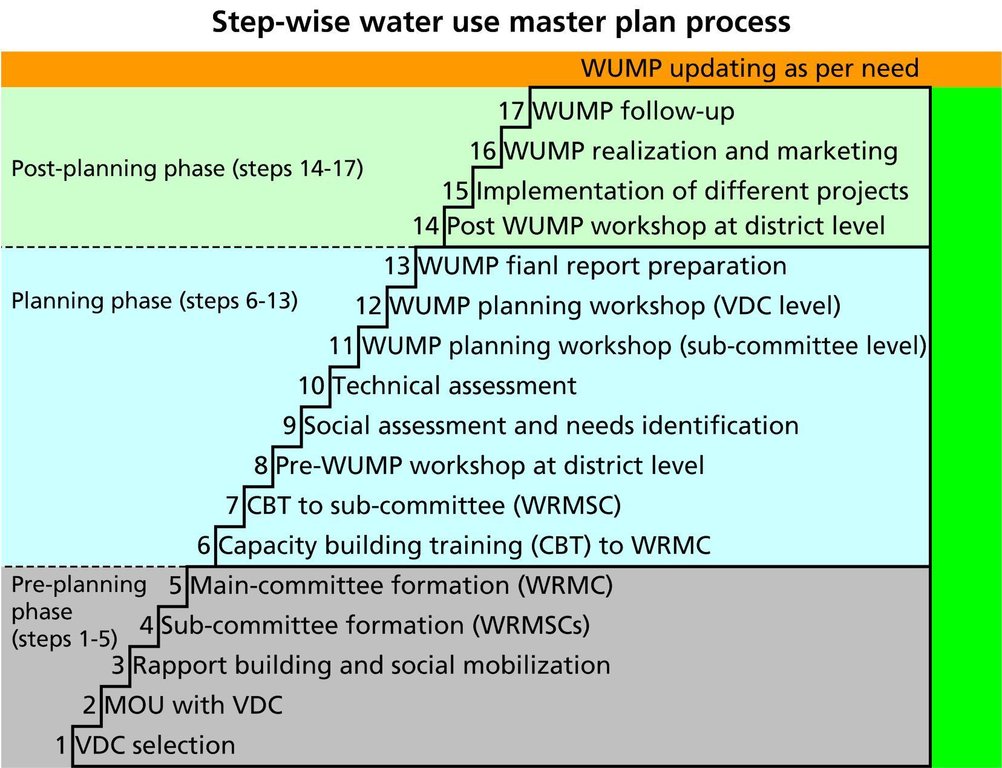Water use master plan [Nepal]
- Creación:
- Actualización:
- Compilador: Shreedip Sigdel
- Editor: –
- Revisor: Fabian Ottiger
Jal upoyog guru yogana (Main Contributor: HELVETAS Nepal)
approaches_2535 - Nepal
Visualizar secciones
Expandir todo Colapsar todos1. Información general
1.2 Detalles de contacto de las personas de referencia e instituciones involucradas en la evaluación y la documentación del Enfoque
Especialista MST:
Jürg Merz
+977 1 5524925; 9851044421 (M)
juerg.merz@helvetas.org.np
HELVETAS Swiss Intercooperation Nepal
Suiza
Nombre de la(s) institución(es) que facilitaron la documentación/ evaluación del Enfoque si fuera relevante)
HELVETAS (Swiss Intercooperation)Nombre de la(s) institución(es) que facilitaron la documentación/ evaluación del Enfoque si fuera relevante)
ICIMOD International Centre for Integrated Mountain Development (ICIMOD) - Nepal1.3 Condiciones referidas al uso de datos documentados mediante WOCAT
¿Cuándo se compilaron los datos (en el campo)?
01/03/2013
El compilador y la/s persona(s) de referencia claves aceptan las condiciones acerca del uso de los datos documentados mediante WOCAT :
Sí
2. Descripción del Enfoque MST
2.1 Breve descripción del Enfoque
A water use master plan supports the development of integrated water resources at the local level; all stakeholders, including disadvantaged groups, take part in the plan.
2.2 Descripción detallada del Enfoque MST
Descripción detallada del Enfoque MST:
Aims / objectives: A water use master plan (WUMP) is a holistic, participatory, and inclusive planning process that takes an integrated approach to the management of water resources and uses at the village level. The WUMP specifies the total water budget for its planning unit, the village development committee (VDC), and explores potential uses for it. It empowers marginalized groups to claim their rights to an equitable share of water within and between communities. The WUMP also helps local bodies with annual and periodic planning and project prioritization.
Methods: The WUMP is a 17-step process that includes social mobilization, the formation of inclusive management committees, capacity building for everyone involved in the process, and, as a final step, social assessment using various participatory rural appraisal (PRA) tools. Simultaneously, the technical part of the process evaluates the capacity of all water resources and their potential uses. In a workshop facilitated by NGO staff, the community discusses suggestions formulated by the two participatory assessments, prioritizes possible projects, and formulates plans. The VDC representatives decide which plans can be implemented using their own resources and which need external support. The WUMP then organizes a workshop to present these plans to various organizations in order to get their commitment and support. The prioritized projects are implemented according to the WUMP.
The plan also contains a series of long-term activities and during the course of its implementation, there is sufficient latitude to allow the community to rectify its original plans in order to put into practise lessons learned during earlier phases and to continue to review and modify the plan as needed.
2.3 Fotos del Enfoque
2.5 País/ región/ lugares donde el Enfoque fue aplicado
País:
Nepal
Especifique más el lugar :
15 districts in the Western, Mid-Western, and Far-Western Development Regions of Nepal
2.7 Tipo de Enfoque
- proyecto/ basado en un programa
2.8 Propósitos/ objetivos principales del Enfoque
The Approach focused mainly on SLM with other activities (Water conservation, water sources and catchment area)
• Establish inclusive water planning and water resource management at the community level
• Ensure the optimal use of water resources; see that water is equitably and efficiently distributed
• Promote conservation of water and natural resources linked to water; implement water projects based on the plan agreed by the entire community
The SLM Approach addressed the following problems: • Issues on access to water are often contentious, communities often quarrel over water rights
• A lack of coordinated planning at the local level
• A growing demand for water both for domestic and agricultural use
• Water sources are diminishing and the changing climate will further aggravate this
2.9 Condiciones que facilitan o impiden la implementación de la/s Tecnología/s aplicadas bajo el Enfoque
normas y valores sociales/ culturales/ religiosos
- impiden
Communities are reluctant to share water resources and
hide the sources of water during planning
Treatment through the SLM Approach: Earn everyone's trust through meetings, dialogue, and social mapping that includes all stakeholders including disadvantaged groups.
disponibilidad/ acceso a recursos y servicios financieros
- impiden
When the WUMP is implemented by the VDC using its
own funds it usually takes a long time.
Treatment through the SLM Approach: Collaborate and network with resource organizations such as INGOs and donor funded programmes for funding.
entorno institucional
- impiden
There is no elected body in the VDC and no one takes permanent ownership of the WUMP.
Treatment through the SLM Approach: Create an advisory body consisting of representatives from all political parties.
marco de trabajo legal (tenencia de tierra, derechos de uso de tierra y agua)
- facilitan
Ensuring equitable use of water resources is a key feature of the WUMP approach.
conocimiento de MST, acceso a apoyo técnico
- impiden
When the administrative boundaries of a VDC do not coincide with its physical watershed boundaries, it can be difficult to make technical decisions.
Treatment through the SLM Approach: Cluster VDCs into groups in the same sub/watershed.
otros
- impiden
Low awareness of the need for conservation and of the
need to use water efficiently
Treatment through the SLM Approach: Intensive awareness raising and capacity building programmes
3. Participación y roles de las partes interesadas involucradas
3.1 Partes interesadas involucradas en el Enfoque y sus roles
- usuarios locales de tierras/ comunidades locales
VDC
Equal participation of men and women is encouraged during the social assessment and needs identification phase. During the planning and implementation phases, the participation of women in decision making is ensured through a provision that there be a representation of at least 33% women in the water resource management committees, sub-committees, and users' committees. Disadvantaged groups (Dalit and Janajati among others) are requested to participate in numbers proportional to the percentage they represent in the community in all activities and committees.
- profesores/ niños en edad escolar/ estudiantes
- ONG
HELVETAS
- gobierno nacional (planificadores, autoridades)
3.2 Involucramiento de los usuarios locales de tierras/ comunidades locales en las distintas fases del Enfoque
| Involucramiento de los usuarios locales de tierras/ comunidades locales | Especifique quién se involucró y describa las actividades | |
|---|---|---|
| iniciación/ motivación | interactivo | Community meetings, decision taken by the VDC on how to prepare the WUMP |
| planificación | interactivo | Social and resource mapping, social assessments, technical assessments and planning |
| implementación | auto-movilización | Implementation of the water projects, source protection/conservation |
| monitoreo y evaluación | interactivo | Review of the plan, community monitoring during the construction phase, follow-up monitoring during routine operation |
| Research | ninguno |
3.3 Flujograma (si estuviera disponible)
Descripción:
The step-wise WUMP process
VDC = Village development committee
MOU = Memorandum of understanding
WRMC = Water resource management committee
WRMSC = Water resource management sub-committee
WUMP = Water use master plan
(AK Thaku)
3.4 La toma de decisiones en la selección de Tecnología(s) MST
Especifique quién decidió la selección de las Tecnología/ Tecnologías a implementarse:
- principalmente usuarios de tierras con el apoyo de especialistas MST
Explique:
Technologies are selected on the basis of suitability and availability of water sources by local communities with the support of technicians and the VDC.
Decisions on the method of implementing the SLM Technology were made by mainly by land users supported by SLM specialists. Since the VDC endorses the WUMP, it decides on implementation.
4. Apoyo técnico, fortalecimiento institucional y gestión del conocimiento
4.1 Construcción de capacidades / capacitación
¿Se proporcionó la capacitación a usuarios de tierras/ otras partes interesadas?
Sí
- Local Community
Temas avanzados:
• Social mobilization and awareness raising orientations, training
• Capacity building and training to WRMC and local service providers
4.3 Fortalecimiento institucional (desarrollo institucional)
¿Se establecieron o fortalecieron instituciones mediante el Enfoque?
- sí, mucho
Especifique el nivel o los niveles en los que se fortalecieron o establecieron las instituciones:
- local
Especifique el tipo de apoyo:
- construcción de capacidades/ entrenamiento
- equipo
Proporcione detalles adicionales:
Support is provided to the VDC for the preparation of the WUMP
4.4 Monitoreo y evaluación
¿El monitoreo y la evaluación forman parte del Enfoque?
Sí
Comentarios:
bio-physical aspects were monitored through measurements; indicators: Follow-up monitoring to check if the water sources are protected, and if the area is conserved by planting
technical aspects were monitored through measurements; indicators: Follow-up monitoring to check water sources and number of water projects implemented
socio-cultural aspects were monitored through measurements; indicators: Public hearings and audits to ensure transparency and community participation (especially of disadvantaged groups)
area treated aspects were monitored through measurements; indicators: Follow-up monitoring of implementation (as shown in the diagram )
no. of land users involved aspects were monitored through measurements; indicators: Public review, final commissioning: community contribution and participation (as shown in the diagram)
management of Approach aspects were monitored through measurements; indicators: WUMP follow-up: implementation of WUMP (as shown in the diagram )
Implementation of WUMP aspects were monitored through measurements; indicators: WUMP follow-up: implementation of WUMP (as shown in the diagram )
There were few changes in the Approach as a result of monitoring and evaluation: • All members of the community, even those with water resources on their own land, are willing to share water resources after participating in the WUMP.
• Disadvantaged groups participate on an equal footing in management committees and have equal access to water resources.
• The community realizes the need to protect water resources and begins to conserve water.
5. Financiamiento y apoyo material externo
5.1 Presupuesto anual para el componente MST del Enfoque
Si no se conoce el presupuesto anual preciso, indique el rango:
- 2,000-10,000
Comentarios (ej. fuentes principales de financiamiento/ donantes principales):
Approach costs were met by the following donors: national non-government: 75.0%; local community / land user(s): 25.0%
5.2 Apoyo financiero/material proporcionado a los usuarios de tierras
¿Los usuarios de tierras recibieron financiamiento/ apoyo material para implementar la Tecnología/ Tecnologías? :
No
5.3 Subsidios para insumos específicos (incluyendo mano de obra)
- ninguno
Si la mano de obra de usuarios de tierras fue un insumo sustancial, ¿fue:
- voluntario?
5.4 Crédito
¿Se proporcionó crédito bajo el Enfoque para actividades MST?
No
6. Análisis de impacto y comentarios de conclusión
6.1 Impactos del Enfoque
¿El Enfoque ayudó a los usuarios de tierras a implementar y mantener Tecnologías MST?
- No
- Sí, un poco
- Sí, moderadamente
- Sí, mucho
Water, forests, and land are all interlinked. Proper management of water resources, source protection, and conservation are all part of sustainable land management.
¿El Enfoque empoderó a grupos en desventaja social y económica?
- No
- Sí, un poco
- Sí, moderadamente
- Sí, mucho
Disadvantaged groups participate and share benefits on equal terms.
Did other land users / projects adopt the Approach?
- No
- Sí, un poco
- Sí, moderadamente
- Sí, mucho
This approach has been replicated by the Rural Water Resources Management Project of FINNIDA, the LIVE/EU project, and Nepal Water for Health (NEWAH), a national-level NGO in Nepal. Nepal's Ministry of Local Development, Department of Local Infrastructure and Roads, has expressed an interest in developing WUMPs for all the VDCs in Nepal.
Did the Approach lead to improved livelihoods / human well-being?
- No
- Sí, un poco
- Sí, moderadamente
- Sí, mucho
Having access to sustainable water resources improves livelihoods.
Did the Approach help to alleviate poverty?
- No
- Sí, un poco
- Sí, moderadamente
- Sí, mucho
Access to water improves hygiene and contributes to better health and to poverty alleviation.
6.2 Motivación principal del usuario de la tierra para implementar MST
6.3 Sostenibilidad de las actividades del Enfoque
¿Pueden los usuarios de tierras sostener lo que se implementó mediante el Enfoque (sin apoyo externo)?
- incierto
Si respondió no o incierto, especifique y comente:
In order to ensure sustainability the following issues need to be addressed:
• Social: Coordinated planning in consultation with the local people; capacity building at all levels so that management committees, local service providers, local government, and the community as a whole can participate better, voice their concerns, and be part of the solution.
• Economic: The VDCs take a lead role, the beneficiaries need to be willing to share the costs and need to want to participate in activities such as quality control, and routine operation and maintenance schemes.
• Environment: Conservation of water sources, integrated water resources planning, and the efficient use of water
6.4 Fortalezas/ ventajas del Enfoque
| Fuerzas/ ventajas/ oportunidades desde la perspectiva del compilador o de otra persona de referencia clave |
|---|
| Communities appreciate the WUMP approach (How to sustain/ enhance this strength: The Ministry of Local Development has expressed an interest in preparing national guidelines for this process in order to scale it up to all the VDCs in Nepal) |
| VDCs own the process both by participating and by contributing to the funding. (How to sustain/ enhance this strength: Need to simplify the process and make it more cost effective so that it is easier to replicate.) |
| An integrated approach to the use of water resources may help in climate change adaptation. (How to sustain/ enhance this strength: Strengthen awareness activities and continue to promote water conservation) |
|
The WUMP process is inclusive and is managed by the whole community. (How to sustain/ enhance this strength: Continue to strengthen the capacity of disadvantaged groups so that they can participate more actively.) |
6.5 Debilidades/ desventajas del Enfoque y formas de sobreponerse a ellos
| Debilidades/ desventajas/ riesgos desde la perspectiva del compilador o de otra persona de referencia clave | ¿Cómo sobreponerse a ellas? |
|---|---|
| Not all VDCs actively participate in the WUMP | When VDCs contribute funds for the WUMP, they are usually more actively involved. |
| Communities can have high expectations for WUMP but their VDCs may have limited resources. | The VDCs need to communicate clearly with their community so that they can prepare a realistic plan together. |
| Conflicts can arise over the allocation of water resources | The VDC and the management committee must work with the community to see that any contentious issues are resolved equitably |
|
At times it can be difficult to get everyone to agree to a given WUMP. |
The VDC authorities can improve their negotiating skills in order to make their demands heard with donors and district development committees. |
7. Referencias y vínculos
7.1 Métodos/ fuentes de información
- visitas de campo, encuestas de campo
- entrevistas con usuarios de tierras
7.2 Referencias a publicaciones disponibles
Título, autor, año, ISBN:
Water use master plan preparation guideline. Lalitpur, Nepal: WARM-P/HELVETAS; Rural Village Water Resource Management Project (2011) Proceedings of water use master plan national level experience sharing workshop. Lalitpur, Nepal, HELVETAS (2007)
Vínculos y módulos
Expandir todo Colapsar todosVínculos
No hay vínculos
Módulos
No se hallaron módulos


